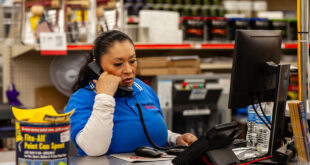A hardware store is full of sharp objects and dangerous chemicals. That’s just the nature of what you have to sell to be in the business. But you also need to keep your store safe for your customers and employees. It’s a good idea to give yourself a regular safety audit so you can spot potential problems before they turn into a disaster. Here are some common areas where you might be able to spot a safety violation. While the information here is a good starting point, always consult OSHA rules or a professional safety expert for a comprehensive list of what you need to do to safeguard your operation.
Employee Training
Make sure all employees are properly trained on safety, and don’t make this just a part of the new-hire orientation process. Make it a habit to regularly review safety protocol so it stays top-of-mind for everyone. You might even appoint a safety committee responsible for regular safety inspections and identifying accident-prone areas in the store. The North American Retail Hardware Association’s (NRHA) course in Store Safety can also help employees understand safety issues around the store. Go to nrha.org and click on the training tab for more information.
Store Entrance
The danger of slips and falls can start at the front door. It’s a good idea to have rubber or carpeted mats to help dry off wet shoes and eliminate snow and ice that might get tracked in from the outside. Quality mats should reach about 15 feet into the store and lay flat so as to prevent trips. They should also have a slip resistant backing and be easy to clean. If water does make its way into the interior, make sure all employees are on the alert to mop wet areas and put out proper signage.
Hazardous Chemicals
All poisonous chemicals, solvents and fertilizers should be clearly labeled and safety warnings on packaging should be facing out on the shelves. Store liquid chemicals below solid items so liquids, if they were to accidentally spill, do not damage something else. If there is a spill, clean it up immediately and ventilate the area to get rid of dangerous fumes.
Merchandising
Monitor each aisle of the store for tripping hazards that can be created throughout the hustle and bustle of a shopping day. Long handled tools and bulk items should be neatly organized so they don’t fall into the aisle. Floor displays should be at least 3 feet tall to reduce a tripping hazard. Secure heavy or awkward merchandise so it doesn’t fall into the aisle, or place signage directing customers to ask for assistance when retrieving those items. Ensure all saw blades have protective guards.
Ladders
When retrieving merchandise off a top shelf, It’s best to use a proper stock ladder with a stable base; never use an extension ladder. If you use stepladders in the store, make sure they are kept in good condition and not missing any parts. Keep ladders off the salesfloor unless an employee directly attends them. Customers should not use them. Ladders for sale should be chained with signage directing customers to ask for assistance if they would like to buy one.
 Hardware Retailing The Industry's Source for Insights and Information
Hardware Retailing The Industry's Source for Insights and Information






